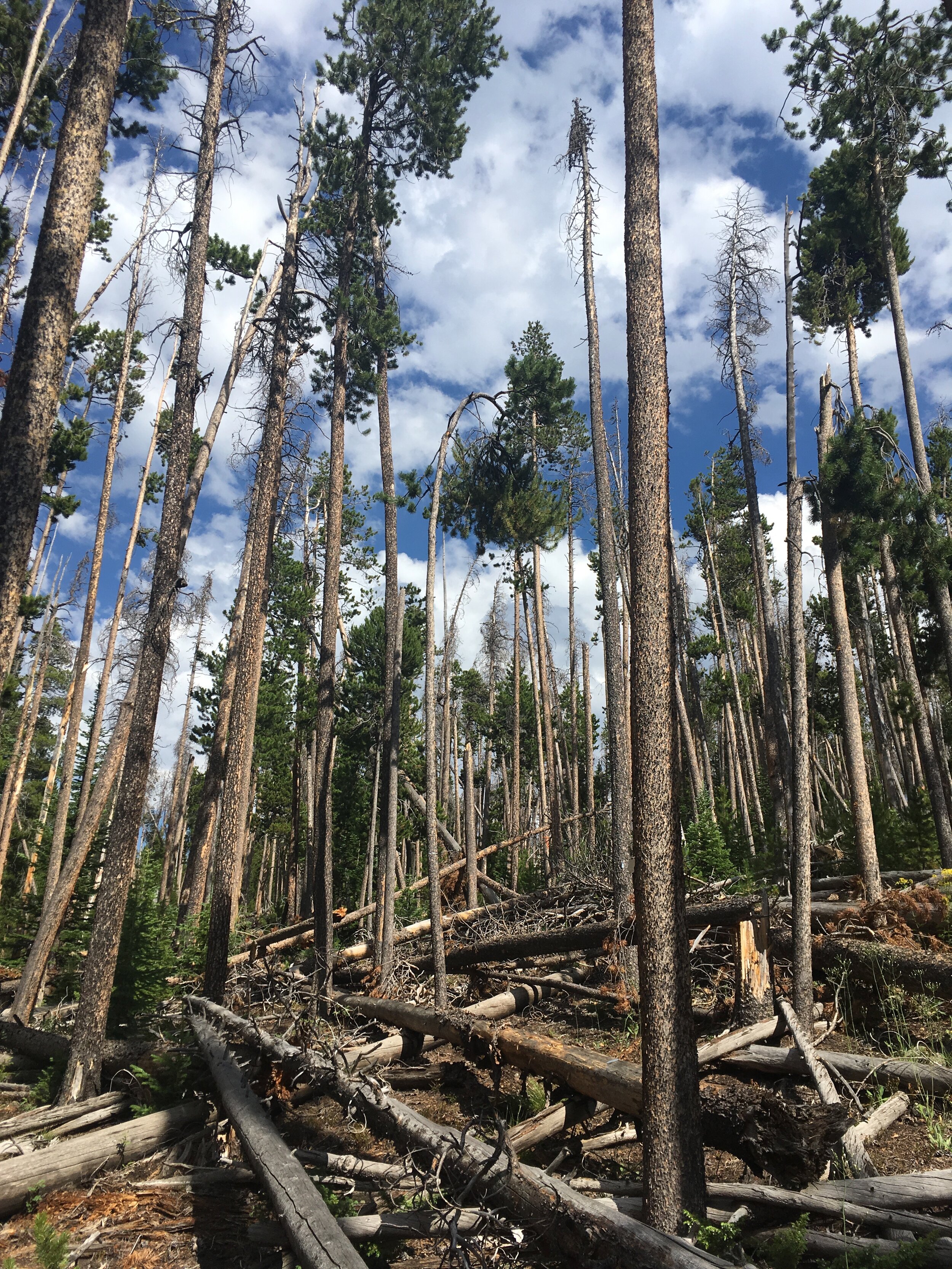Seeing the forest for the (dead) trees
It’s mid-July, 2018. As I step into my office, 9,000 feet above sea level in the Colorado Rocky Mountains, my feet fall on a forest floor littered with fallen branches and dry pine needles. I shade my eyes from the sun, shining bright through the empty canopies of dead trees. The unnerving creak of these lifeless giants as they sway in the wind competes with the sound of my breath, growing heavier as I climb over downed logs collapsed in tangled heaps. I approach a standing dead pine and examine its trunk, scraping away at the thin bark. My suspicions are confirmed: small J-shaped tunnels scar the wood underneath, displaying the undeniable signature of the mountain pine beetle. Looking around, most of the neighboring large pines have suffered a similar fate, their trunks pockmarked with small holes bored by thousands of beetles just a few years earlier. This was not an isolated event; it was a severe outbreak.
A mess of fallen lodgepole pine trees killed during a severe mountain pine beetle outbreak on the Fraser Experimental Forest in Fraser, Colorado. (Credit: Michele Buonanduci, University of Washington)
This narrative defines my work as a disturbance ecologist, measuring tree after dead tree to learn more about how forests respond to fire and insect outbreaks. The lodgepole pines I studied that summer were the victims of a mountain pine beetle outbreak that swept across Colorado and much of the western United States in the mid-2000’s. These native bark beetles attack large, stressed pine trees by feeding and reproducing within the living tissue hidden just beneath the bark, killing the tree in the process. During an outbreak, this process occurs over vast swaths of forest as large numbers of these tiny beetles (the size of a mere grain of rice) prey on stressed trees scattered across entire regions. In fact, they have killed trees over more than 20 million acres of forest across the western U.S. in the last 20 years.
Left: Mountain pine beetle ‘gallery’ carved into a lodgepole pine tree.
Right: Adult mountain pine beetle. (Credit: Whitney Cranshaw, Colorado State University)
As an individual tree, the effects of bark beetles are certainly undesirable. Yet, if we consider the forest as a whole, outbreaks are not cause for alarm. Rather, these disturbances are a natural—and important—part of healthy forests. Beetle-killed trees create wildlife habitat for birds and small mammals, enrich the soil as they decompose, and provide space for other plant species to thrive; surviving trees grow into the next generation of the forest. In this way, bark beetles resemble engineers, revitalizing forest structure every few decades.
However, with climate change, we’re seeing these typical outbreaks become less familiar. They’re shifting pace, growing more intense, and affecting broader areas as warmer and drier conditions increase populations of both beetles and stressed trees across the landscape. These changing outbreaks raise concerns about the future of our forests, and create a huge challenge for managers tasked with maintaining forest benefits—things like clean air, recreation, and cultural and economic resources.
My research addresses this challenge by examining how thinning (selective tree removal) may promote forest resilience to future beetle outbreaks. By removing the most susceptible trees in an area, thinning frees up resources for trees that remain, increasing their ability to defend themselves against attacking beetles. Thinning can also promote the growth of trees less desirable to the beetles (ones that are too small or the wrong species) and may reduce fire hazard following a severe outbreak.
Left: Area without treatment prior to mountain pine beetle outbreak on the Fraser Experimental Forest. Note the openness, abundance of dead trees, and _.
Right: Area thinned 60 years prior to outbreak on the Fraser Experiment Forest. Note the greater abundance of live trees, denser canopy overhead, and a lesser amount of fallen woody debris on the forest floor compared to the untreated area.
While the effects of bark beetles are hard to ignore, my work demonstrates hopeful insight into how we can help protect our forests in the face of changing disturbances. By broadening our gaze beyond individual trees, we are able to see the forest as a whole, dead trees and all.
Jenna Morris is an ecologist studying the ways forests respond to disturbances like fire and insect outbreaks. Her current research explores how management activities and bark beetle outbreaks interact to shape forests across western North America, with implications for improving our ability to maintain resilient forest structure and function in a changing climate.





